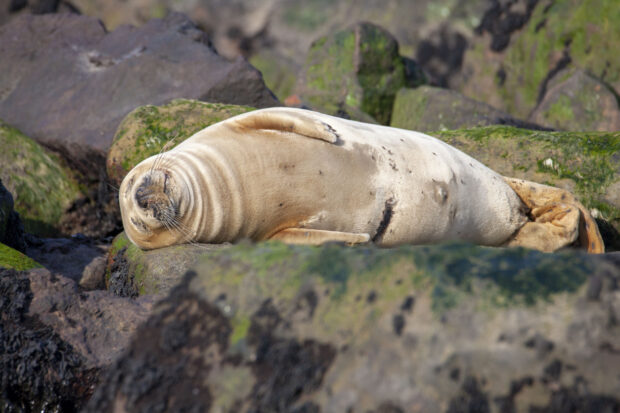
Britain is home to two species of seals: the grey seal (Halichoerus grypus) and the common or harbour seal (Phoca vitulina). While they usually spend their time lounging on beaches to conserve energy, they occasionally wander into more hazardous environments.
They bounce along on the land, which is called galumphing. It’s a charming word but sometimes, seals can galumph themselves into places they really shouldn’t be.
From car parks and gardens to railway tracks and busy roads, seals don’t understand the dangers they face, or the risks they pose to people.
When a nap becomes a hazard
In these situations, it may be necessary to move a seal to a safer location. But before you do, it’s important to understand the legal protections in place.
Under the Conservation of Seals Act 1970, it is an offence to intentionally or recklessly kill, injure, or take a seal. However, there is an important exception: if a seal is disabled and needs care, it can be moved and released once it has recovered.
This means that if a seal is clearly injured, sick, or too young to survive on its own, it can be moved without a wildlife licence provided the intention is to care for and release it.
But what if the seal is healthy?
How we define a healthy seal
A healthy seal is one that:
- is mobile and alert and shows no visible signs of injury or illness; and
- is not a dependent pup (i.e. it has been weaned and is capable of independent survival)
Even if a healthy seal is in a dangerous location such as a road, urban area, or near heavy machinery it is still protected by law. In these cases, a wildlife licence is required to move it, because the general exception does not apply.
Moving a healthy seal - You’ll need a licence
If a seal is not disabled but is in a location that poses a risk to itself or to humans, such as a busy street or a residential area, a wildlife licence is required to move it. This is because the legal defence for tending to a disabled animal does not apply to healthy ones.
What should you do?
- If you see a seal in distress, contact a rescue organisation like the British Divers Marine Life Rescue (BDMLR).
- If you’re part of a rescue organisation and you move healthy seals for safety reasons, you must have the appropriate wildlife licence. We encourage you to apply for a licence now. This will ensure you are able to respond to future incidents where a healthy seal may need to be moved.
- Before relocating a seal, consider other ways to reduce the risk, such as setting up temporary barriers or working with local authorities.
🦭 Fun Facts About Seals
- Seals can sleep underwater on the seabed. While harbour seals can manage half an hour underwater, grey seals can stay for an hour or more.
- Grey seals can dive to a depth of 300 metres in search of food.
- Each seal has a unique fur pattern, like a fingerprint, which researchers can use to identify individuals.
- They’re surprisingly vocal. Seals make a variety of sounds - grunts, barks, and even eerie wails to communicate, especially during breeding season.
- Grey seal pups are born with a white fluffy coat, and have to stay out of the water, whereas harbour seal pups are ready to swim within a few hours of their birth.
Need More Information?
For guidance on seal protection and licensing, visit Seals - GOV.UK .
If you have questions about licensing the movement of healthy seals, contact the Marine Conservation Team:
📞 0300 123 1032
📧 conservation@marinemanagement.org.uk